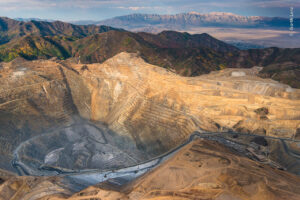The annual Wildlife Photographer of the Year exhibit, developed and produced by the Natural History Museum in London, features a local touch this year: one of the almost 100 photos chosen to be featured was taken by Victoria’s Garth Lenz. Currently displayed at the Royal BC Museum, Lenz’s photo shows the world’s largest open pit mine—a copper mine in Utah—juxtaposed against the lush mountain landscape and nearby city.
“[What’s important is] the ability to tell a complete story in one picture,” says Lenz. “Because a lot of time that’s all the space you have in some magazines. Even National Geographic, where they’re doing a big special issue on forests, and you get one image to tell that story. And so images like the one in this exhibit, I think, accomplish that more than if you were just photographing the devastation or just photographing the intact landscape.”

Lenz has developed a particular focus on resource extraction for his photography. Pointing his camera both across the globe and closer to home, Lenz looks for more than documentation—he’s also interested in the fleeting moments of beauty to be found in our destruction.
“I’m very interested—both in the editorial and aesthetic sense—with large-scale extractive industries. You know, first with clear-cut logging, not just here, but all over the US and in Chile, and Ecuador,” he says. “My first visit to the tar sands, which I’ve made a number of repeated visits to, it’s probably the body of work that I’m best known for. That just fascinated me with the ability to make powerful and surreal… beautiful images of disturbing subjects.”
Despite the elegance of the composition, Lenz is keenly aware of the high cost of these practices and is a passionate advocate for the planet’s environmental protection.
“The image is really about trying to show it in the context of what’s been lost,” he says. “I have oftentimes wanted to show the enormity of the devastation and our best opportunities to preserve large, intact chunks of wilderness.”
Lenz doesn’t see this as a black-and-white issue with a clear resolution, though. One of the ideas Lenz consistently explores in his work is that of our personal relationships with these devastating industries.
“Mining is certainly one of the most destructive exploited industries… It’s complicated because we’re all using this stuff, you know, my phone, your phone, the coffee mugs we’re drinking out of, solar panels, electric cars, all are minerals that are only gotten from digging up the earth,” he says. “We can’t just want to say, ‘Oh, this is a horrible person here digging up the oil that I’m using in the gasoline in my car, or to fly on my next vacation.’ You know, we have to take responsibility, as well. We’re all part of the problem, and we all need to be part of the solution.”
To aspiring photographers, Lenz encourages boldness. He says that people need to do what they’re passionate about, because there may not be rewards for quite a while.
“It’s not the easy path to supporting yourself… and I think photography, especially this kind of photography, is increasingly difficult to earn a living in. But if you wouldn’t be happy doing anything else, then throw yourself into it and give it your best shot,” he says. “Reach out. You know, you’ll be surprised how open people are that you might see in some magazine or whatever. Send them an email… You know, most of us are pretty nice. And most of us have been in that position before and someone was nice to us.”
Lenz urges photographers and environmental defenders alike to embrace nuance and fight for what they believe in.
“Follow your passion,” he says. “Work hard.”
Wildlife Photographerof the Year
Until Sunday, June 2
Royal BC Museum
royalbcmuseum.bc.ca
